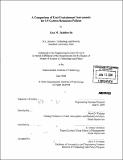A comparison of cost-containment instruments for US carbon reduction policies
Author(s)
Jakobovits, Lisa M. (Lisa Michelle)
DownloadFull printable version (33.91Mb)
Other Contributors
Massachusetts Institute of Technology. Technology and Policy Program.
Massachusetts Institute of Technology. Engineering Systems Division.
Advisor
Mort D. Webster and A. Denny Ellerman.
Terms of use
Metadata
Show full item recordAbstract
A cap-and-trade program, as is used in the European Trading Scheme, is currently the most widely discussed method in the US for reducing greenhouse gases. A basic cap-and-trade program operates by mandating a fixed level of emissions for a given period, issuing permits, and then allowing a market for those permits to develop. The resulting market price for emissions permits, and hence the economic impacts of the chosen policy, can only be estimated in advance with a high degree of uncertainty. Many of the current US cap-and-trade proposals contain provisions for cost-containment instruments which reduce the possible range of emissions prices. This paper analyzes the relative effectiveness of three such cost-containment instruments, including a safety valve, an intensity target, and banking and borrowing. The results presented rely on two computable general equilibrium models developed at the Massachusetts Institute of Technology, and show the predicted performance of these instruments under a simulated range of economic outcomes.
Description
Thesis (S.M. in Technology and Policy)--Massachusetts Institute of Technology, Engineering Systems Division, Technology and Policy Program, 2008. Includes bibliographical references (p. 124-126).
Date issued
2008Department
Massachusetts Institute of Technology. Engineering Systems Division; Technology and Policy ProgramPublisher
Massachusetts Institute of Technology
Keywords
Technology and Policy Program., Engineering Systems Division.